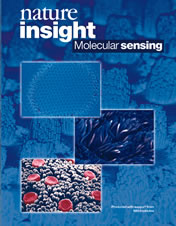Molecular
sensing
Vol.
413, No. 6852 (13 September 2001).
|![]() PDF
PDF![]() (115
(115![]() K)
K)![]() |
|
 |
| Cover
illustration |
The loss of a sense is not life threatening, yet it can severely affect
one's quality of life. The first and crucial step in sensory processing —
the transduction of stimuli, such as odour, light and sound, into a cellular response
— takes place in specialized cells that form an interface between our environments
and our nervous systems. Each sense has evolved a transduction mechanism so finely
tuned that it is able to discriminate between different stimuli with both speed
and sensitivity.
The past few years have seen an explosion in the identification of molecules involved in the different transduction mechanisms. Indeed, this year heralds the tenth anniversary of the discovery of the first odour receptors. These receptors belong to a large family of G-protein-coupled receptors, which amplify signals via intracellular signalling cascades — a mechanism shared by several other senses including vision and taste.
The diversity of signals that our senses must encode is vast. It is remarkable therefore that evolution has repeatedly called upon two ion-channel families to impart such functional diversity. TRP channels were discovered in the fruitfly, where they are involved in the transduction of both light and touch. Another family member, VR1, has a direct role in mammalian detection of noxious heat. Similarly, DEG/ENaC family members are involved in senses ranging from touch in nematodes to mineral taste in mammals. Small wonder, then, that such molecular switches are being engineered for use in commercial biosensor devices.
Lesley Anson Senior Editor and Insight Programme
Editor
| Visual
transduction in Drosophila ROGER C. HARDIE AND PADINJAT RAGHU
| 186 | ||
| Molecular
basis of mechanosensory transduction PETER G. GILLESPIE AND RICHARD G. WALKER
| 194 | ||
| Molecular
mechanisms of nociception DAVID JULIUS AND ALLAN I. BASBAUM
| 203 | ||
| How
the olfactory system makes sense of scents STUART FIRESTEIN
| 211 | ||
| Receptors
and transduction in taste BERND LINDEMANN
| 219 | ||
| Stochastic
sensors inspired by biology HAGAN BAYLEY AND PAUL S. CREMER
| 226 | ||
| Molecular
Sensing NIH Institutes
| 232 | ||